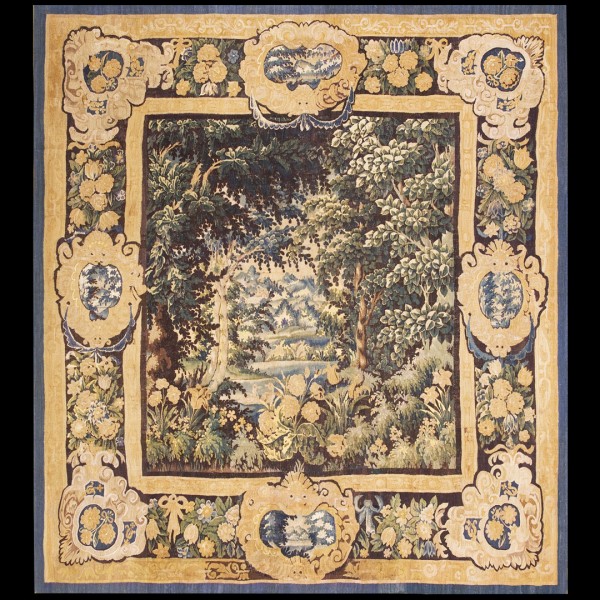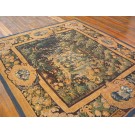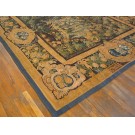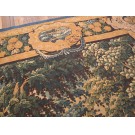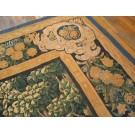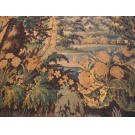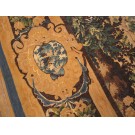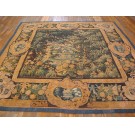18th Century French Verdure Tapestry
French Verdure Tapestry, Probably Beauvais
Linen warps, wool pattern wefts, tapestry weave,
Third Quarter 18th Century
This is a classic example of the verdure genre popular in 18th century Europe and woven in both France and Flanders. In the placid summer landscape, fully foliaged trees press in from each side to frame a deep vista of a meandering stream and rolling hills. Although the trees are generally generic, the large, gnarled one at the left may be intended to be an oak .The tree on the right could be a laurel. The foreground flowers are centred by a yellow blossomed plant with artichoke-style leaves. This is not a rose although the flowers bear a general resemblance. And the leaves do not resemble rose leaves. An equally yellow tulip grows to the right lower right corner next to what might be intended as a daisy. The wide border displays scroll-edged and an iris (?) sprouts in the three dimensional cartouches (escutcheons), some with textile swags, in the corners and at the midpoints of all four sides. Four escutcheons have grotesque masks as further ornaments. These cartouches show either micro-verdure landscapes or daisy/rose flowers repeating those in the field. These illusionistic cartouches are less common than those displaying armorials. The rose/ daisy motif recurs yet again in the border sections between the escutcheons along with other garden flowers. A French Herbal would allow one to exactly identify the various plants. Bows and ribbons are mixed in with the floral bouquets.
The wide border may be construed as a window frame and the verdure scene may therefore be what is seen through that window. The alternative interpretation is a particularly elaborate polychrome picture frame and the scene as a picture,
As to the origin. There is no town mark in the border. All Brussels and other Flemish tapestries were required to have a town mark after the mid-16th century. French tapestries were not. Certainly, this is not a Gobelins creation. Hence, we must look toward Beauvais, or less likely Aubusson, for the source. The exact designer and workshop requires further study for identification.
Verdures were popular in sizes ranging from two by three meters up to more than three by more than five meters throughout the 18th century, either is suites or as singletons. Our example is a pure forest and landscape vista type with no birds, animals, human habitations or figures.
The colours have held quite well with the yellow, often fugitive in period tapestries, still vibrant in the border and flowers. The various greens, combinations of blue and yellow, have retained their depth and variety.
Overall, this is a well- designed and executed decorative verdure with good colours and unusual border touches from the best period of Beauvais weaving.
Linen warps, wool pattern wefts, tapestry weave,
Third Quarter 18th Century
This is a classic example of the verdure genre popular in 18th century Europe and woven in both France and Flanders. In the placid summer landscape, fully foliaged trees press in from each side to frame a deep vista of a meandering stream and rolling hills. Although the trees are generally generic, the large, gnarled one at the left may be intended to be an oak .The tree on the right could be a laurel. The foreground flowers are centred by a yellow blossomed plant with artichoke-style leaves. This is not a rose although the flowers bear a general resemblance. And the leaves do not resemble rose leaves. An equally yellow tulip grows to the right lower right corner next to what might be intended as a daisy. The wide border displays scroll-edged and an iris (?) sprouts in the three dimensional cartouches (escutcheons), some with textile swags, in the corners and at the midpoints of all four sides. Four escutcheons have grotesque masks as further ornaments. These cartouches show either micro-verdure landscapes or daisy/rose flowers repeating those in the field. These illusionistic cartouches are less common than those displaying armorials. The rose/ daisy motif recurs yet again in the border sections between the escutcheons along with other garden flowers. A French Herbal would allow one to exactly identify the various plants. Bows and ribbons are mixed in with the floral bouquets.
The wide border may be construed as a window frame and the verdure scene may therefore be what is seen through that window. The alternative interpretation is a particularly elaborate polychrome picture frame and the scene as a picture,
As to the origin. There is no town mark in the border. All Brussels and other Flemish tapestries were required to have a town mark after the mid-16th century. French tapestries were not. Certainly, this is not a Gobelins creation. Hence, we must look toward Beauvais, or less likely Aubusson, for the source. The exact designer and workshop requires further study for identification.
Verdures were popular in sizes ranging from two by three meters up to more than three by more than five meters throughout the 18th century, either is suites or as singletons. Our example is a pure forest and landscape vista type with no birds, animals, human habitations or figures.
The colours have held quite well with the yellow, often fugitive in period tapestries, still vibrant in the border and flowers. The various greens, combinations of blue and yellow, have retained their depth and variety.
Overall, this is a well- designed and executed decorative verdure with good colours and unusual border touches from the best period of Beauvais weaving.
| Stock ID: | #20986 |
| General Rug Type: | European |
| Specific Rug Type: | Tapestry |
| Circa: | 1780 |
| Ground Color: | Forest Green |
| Border Color: | Apricot |
| Origin: | France |
| Material: | Wool |
| Weave: | Flat Weave |
| Shape: | Square |
| Width: | 9' 8" ( 295 cm ) |
| Length: | 10' 4" ( 315 cm ) |
| Tearsheet Download |
